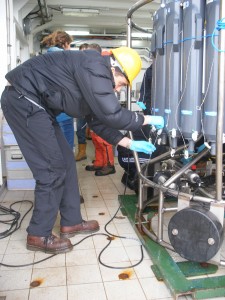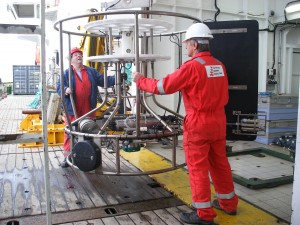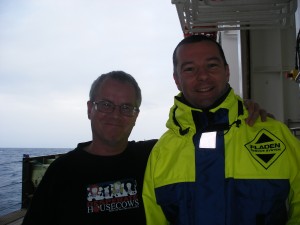First blood to the chemists! Late this afternoon the rather uncharismatically named CTD took a trip to 3000m. Pressure at this depth is phenomenal, squeezing any air into a space about 1/300th of that it would occupy on the surface. Take a good football down to that depth and it would look flat. There would not be enough air in it to fill a ping-pong ball yet none of the air escaped.
The CTD derives its name from the information it gathers. In days of old the core readings taken by the CTD were Conductivity[salinity], Temperature and Depth[pressure]), today’s kit does so much more. The top section of the equipment houses a rack of 24 water sampling bottles (niskin bottles). They are open tubes with spring loaded ends. Water just flows through the tubes as the CTD sinks until we “fire” the bottles at the target depth. The ends then close capturing a sample of water from a very specific depth. We can fire any number of the bottles at a time. Today it was 4 bottles at each of 6 different depths
The bottom section of the CTD houses the instruments. They can be seen more clearly in the third photo below where the bottles were removed for a second dip. In addition to C,T and D we also have a light scattering sensor that measures the number of particles in the water and an Eh metre. The whole package gives quite a detailed picture of the character of the water.
Water has a chemical finger print based on temperature salinity and so on. Generally speaking warm and fresh waters float on top of cold and salt water creating different water layers (different combinations of these are more challenging). These layers can flow in different directions and have come from different places. Understanding the structure of the water column is important for example in knowing how heat from the sun is distributed around the earth creating a more uniformly heated planet than would otherwise occur.
However, that is not why we are here. We are searching for hydrothermal vents and they spew out masses of super-hot water with lots of chemicals in it [more on these in the future]. The effect is like smoke from a chimney rising into the sea and floating off on an aquatic breeze. Soon we will go searching for that smoke plume. But first we need to know what is a normal background water finger print for the area before we can trace the abnormal to its source. That was today’s task…completed successfully. As the sun began to set the chemists retreated to their labs, like little children with presents at Christmas, to start analyzing gasses, several nutrients and metals.
Putting up a brave front in the face of all this chemistry was a lone microbiologist, Anni, who is collecting and then filtering water to analyses what bacteria are growing in the water. Watch this space as microbes are the key to the fantastic life to be found at hydrothermal vents.
Chris





